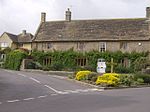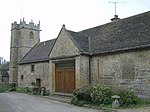Chetnole

Chetnole is a village and civil parish in the county of Dorset in southern England. It lies approximately 6 miles (9.7 km) south-southwest of Sherborne and 5.5 miles (8.9 km) southeast of Yeovil in Somerset. It is sited on Oxford clay by the small Wriggle River at the western end of the Blackmore Vale. There are around 128 houses in the village. It has a railway station on the Heart of Wessex Line that is served by Great Western Railway services. Dorset County Council estimate that in 2013 the population of the parish was 330. In the 2011 census the population of Chetnole parish combined with the small parish of Stockwood to the west was 344.Chetnole was not recorded in the Domesday Book in 1086.
Excerpt from the Wikipedia article Chetnole (License: CC BY-SA 3.0, Authors, Images).Chetnole
Mill Lane,
Geographical coordinates (GPS) Address Nearby Places Show on map
Geographical coordinates (GPS)
| Latitude | Longitude |
|---|---|
| N 50.8701 ° | E -2.5669 ° |
Address
Mill Lane
Mill Lane
DT9 6PB , Chetnole
England, United Kingdom
Open on Google Maps










